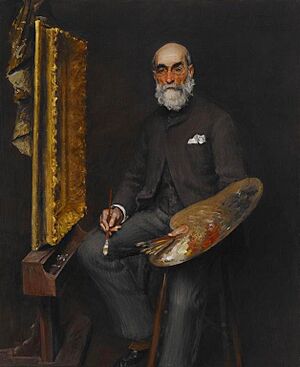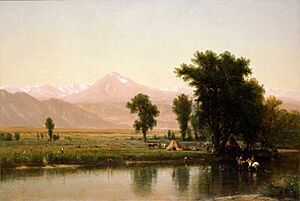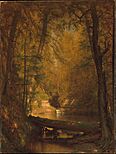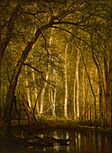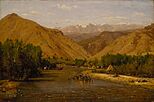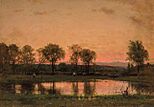Worthington Whittredge facts for kids
Thomas Worthington Whittredge (born May 22, 1820 – died February 25, 1910) was an American artist. He was famous for his beautiful landscape paintings. He was part of the Hudson River School, a group of artists who painted amazing scenes of nature.
Whittredge was well-known in his time. He was friends with other important artists like Albert Bierstadt and Sanford Robinson Gifford. His paintings are now in many major museums. He even led the National Academy of Design for a time.
Contents
Early Life in Ohio
Worthington Whittredge was born in a log cabin in Ohio in 1820. His family lived near the Little Miami River. Before he was born, his family lived in New England. His father had been a sea captain.
As a boy, Worthington loved trapping animals. He was very good at it! He earned a lot of money by trapping and selling animal furs. He often went out in bad weather to check his traps.
He worked hard on his father's farm. He spent most of his first 16 years in the fields and forests. He did not go to school much until he was about 17 years old.
Becoming an Artist
When he was older, his parents let him go to Cincinnati, Ohio. He lived with his sister there. He started working as a house painter.
Worthington really wanted to be an artist. But his father did not approve. His father thought painting was a waste of time. He believed artists were "lost souls."
Learning to Paint
Whittredge soon moved from house painting to painting signs. He taught himself how to paint at night. For a short time, he made daguerreotypes (early photographs). He also traveled and painted portraits.
But he was not happy with his portraits. He thought they were "colorless, dark, ugly." He felt he wasn't good enough at drawing people. He realized his strengths were with color and simple scenes. These skills were perfect for landscape painting.
In 1843, Whittredge returned to Cincinnati. He began painting landscapes. He learned a lot on his own. He also learned from other artists who lived in or visited the area.
Gaining Recognition
In the 1840s, landscape paintings were very popular. Whittredge painted many of them. He quickly became well-known in his local area. He talked with locals and met wealthy people who supported his art.
In 1846, he sent one of his landscapes to the National Academy of Design in New York. They accepted his painting! The president of the Academy, Asher Brown Durand, even sent him a nice note.
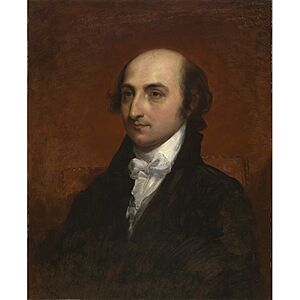
Studying in Europe
Worthington wanted to visit Europe. He got many orders for paintings before he left. This meant he would have work when he got there. He wanted to go to Europe for three reasons:
- To improve his painting skills.
- To study the art of other famous artists.
- To learn from art masters of the time.
He arrived in London on his 29th birthday, May 22, 1849.
Life in Germany
In Germany, he settled at the Düsseldorf Academy. This was a very important art school back then. He studied with a famous artist named Emanuel Leutze.
At Düsseldorf, Whittredge became friends with Albert Bierstadt. He even posed for Leutze's famous painting, Washington Crossing the Delaware. Whittredge posed as both George Washington and a boatman in the painting. This artwork is now at the Metropolitan Museum of Art in New York City.
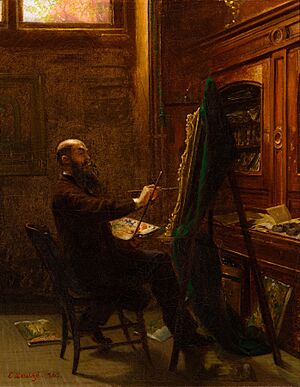
Whittredge stayed in Europe for almost ten years. He met and traveled with other important artists, like Sanford Gifford. He returned to the United States in 1859. He settled in New York City. There, he started his career as a landscape artist. He painted in the style of the Hudson River School.
Exploring the American West
In 1865, Whittredge took a trip across the Great Plains to the Rocky Mountains. He traveled with his friends Sanford Gifford and John Frederick Kensett. This trip led to some of his most important paintings.
These paintings showed the wide, open spaces of the Plains. They captured the quiet beauty and flat horizon. Whittredge later wrote that the Plains impressed him deeply. He loved them even more than the mountains.
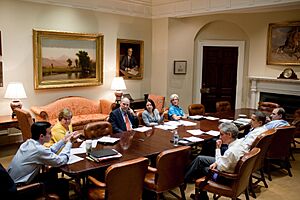
He wrote that anyone who crossed the Plains back then would be amazed by their size and quietness. He felt it showed a simple, natural way of life.
Later Life and Legacy
In 1880, Whittredge moved to Summit, New Jersey. He continued to paint there for the rest of his life. He passed away in 1910 at the age of 89. He was buried in the Springfield, New Jersey cemetery.
Famous Works
Whittredge's paintings are in many museums. You can see his art at:
- The Metropolitan Museum of Art in New York City
- The Utah Museum of Fine Arts in Salt Lake City
- The Smithsonian American Art Museum in Washington, D.C.
- The Louvre Museum in Paris, France
Gallery
See also


